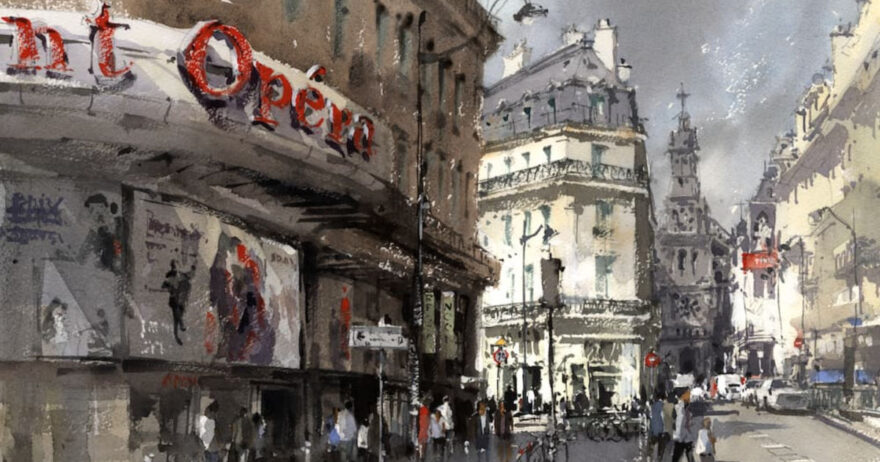Three Planes of Vision

Discover the art of capturing depth and perspective in landscape painting.
By Vladislav Yeliseyev
Whether working en plein air or from photographs, landscape painters have to grapple with an almost boundless source of information. It’s a blessing and a curse. The sheer volume of it all can become overwhelming and make it a challenge to decide what to incorporate, what to edit out, and how to organize everything into a meaningful and impactful work of art. With the myriad considerations a landscape artist must keep in mind, an understanding of how to effectively employ a three-planes-of-vision concept is an invaluable asset.
Our perception of reality is three-dimensional. The challenge of painting, however, is to convey a two-dimensional representation on a flat surface while creating the illusion of depth. Therefore, our aim as artists is to establish visual separation among these three planes in our composition. This is where the three methods of painting on each individual plane come into play.

Break It Down
When it comes to composing and finalizing a landscape, the key lies in simplification. Breaking down the scene into three distinct planes is a practical approach that offers manageability. While, theoretically, one could incorporate as many planes as desired, attempting to control them all would become a convoluted endeavor resulting in a chaotic hierarchy of elements in the composition.
A fundamental and highly effective technique for dividing a landscape into planes is to envision three vertical flat surfaces neatly stacked in succession. Each of these surfaces represents a two-dimensional picture capturing a specific portion of the entire image. The farthest surface constitutes the background, portraying elements of the landscape that are most distant within the picture. Think of it as the backdrop in a theater set, playing a supporting role in the overall production. The plane, moving forward, represents the midground, encompassing the focal area and immediate surroundings as perceived by the artist. The nearest plane, closest to the artist, forms the foreground, which contains all the immediate details and information.
This method is straightforward. Paint each plane as a flat surface without concerning yourself with the need to convey three-dimensionality on each one. Stacking these three flatly painted planes against one another will be enough to generate a sense of depth in the painting.
For the background plane, employ a wet-on-wet painting technique, featuring soft edges, light washes, and muted colors to mimic atmospheric perspective. The use of water bottle sprayers can be quite advantageous in this stage.
The midground plane, featuring the focal area, benefits from high contrast, bold brushwork, and intense color mixes to draw the viewer’s attention. These two planes alone can effectively create a sense of depth.
In reality, we seldom pay attention to our nearest, most immediate surroundings, instead focusing most of our attention on the midground, where the action tends to unfold. Therefore, the level of detail in the foreground plane should be reduced by utilizing the drybrush method. This implies a suggestive approach that distinctly contrasts with the background’s appearance.

Artistic Differences
Every artist perceives the landscape differently. What holds interest for one may hold none for another, and vice versa. Every individual brings their unique perspective and impressions to the canvas. Consequently, the placement of the planes of vision may vary from artist to artist. This is both expected and acceptable, as long as the consecutive order of the planes hasn’t been broken.
One important step in determining the placement of planes is the creation of a monochromatic sketch, whether it be graphite or grisaille. This diversity in perception is one of the reasons why, even within a group of artists painting the same scene, the end results can be strikingly distinct irrespective of skill level.

Moving Toward Mastery
It’s my hope that this method will assist other artists in approaching their own unique landscape paintings with a professional and simplified methodology. Learning how to recognize the planes of vision and organize them into a composition will not only enhance your painting process but eventually help you to master other painting techniques as well.
Painting Venice Canal
Follow along as I use the three planes of vision to create a Venetian water scene.

Step 1: I created a sketch to serve as reference for a full-color painting. It was useful not only as a value study, but also as a clear display of the separation between the background, midground and foreground planes with their respective brushwork execution.

Step 2: I applied light washes to de-emphasize contrast and color in the background plane. Note the very low contrast between the background building and the sky. The colors I used were mixed with a significant amount of water.

Step 3: High contrast and bolder colors were implemented in the midground area to draw attention to this plane. This focal area draws the viewer’s attention, as it’s where the main action takes place, so it’s lit accordingly brightly.

Step 4: I applied a preliminary wash in the foreground area before adding drybrush details. I took this step to reduce the contrast in the foreground plane.

Final Step: To complete Venice Canal (watercolor on paper, 14×19), I added half tones of drybrushed local watercolor washes before applying a unifying wash to the foreground area to further diminish the contrast, in addition to adding details using titanium white gouache mixed with a slight amount of yellow ochre to warm its color temperature. This was done to increase the sense of texture on the walls, along with slight indications of windows in the background building.
Meet the Artist
Vladislav Yeliseyev is a sought-after educator in the watercolor and plein air communities. He conducts virtual, plein air, and studio workshops in addition to hosting art holidays in Europe. The artist holds Signature Memberships in the American Impressionist Society and the National Watercolor Society.
From Our Shop



















Join the Conversation!